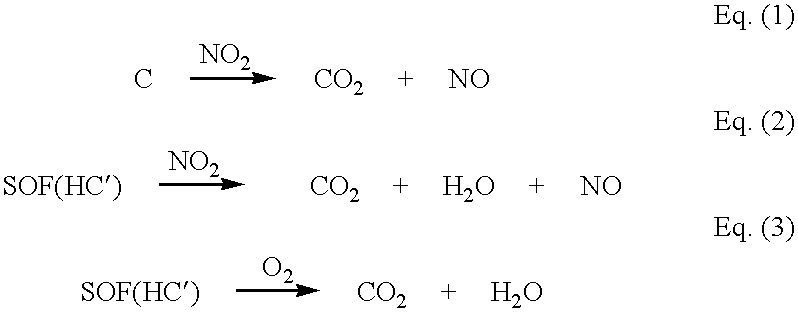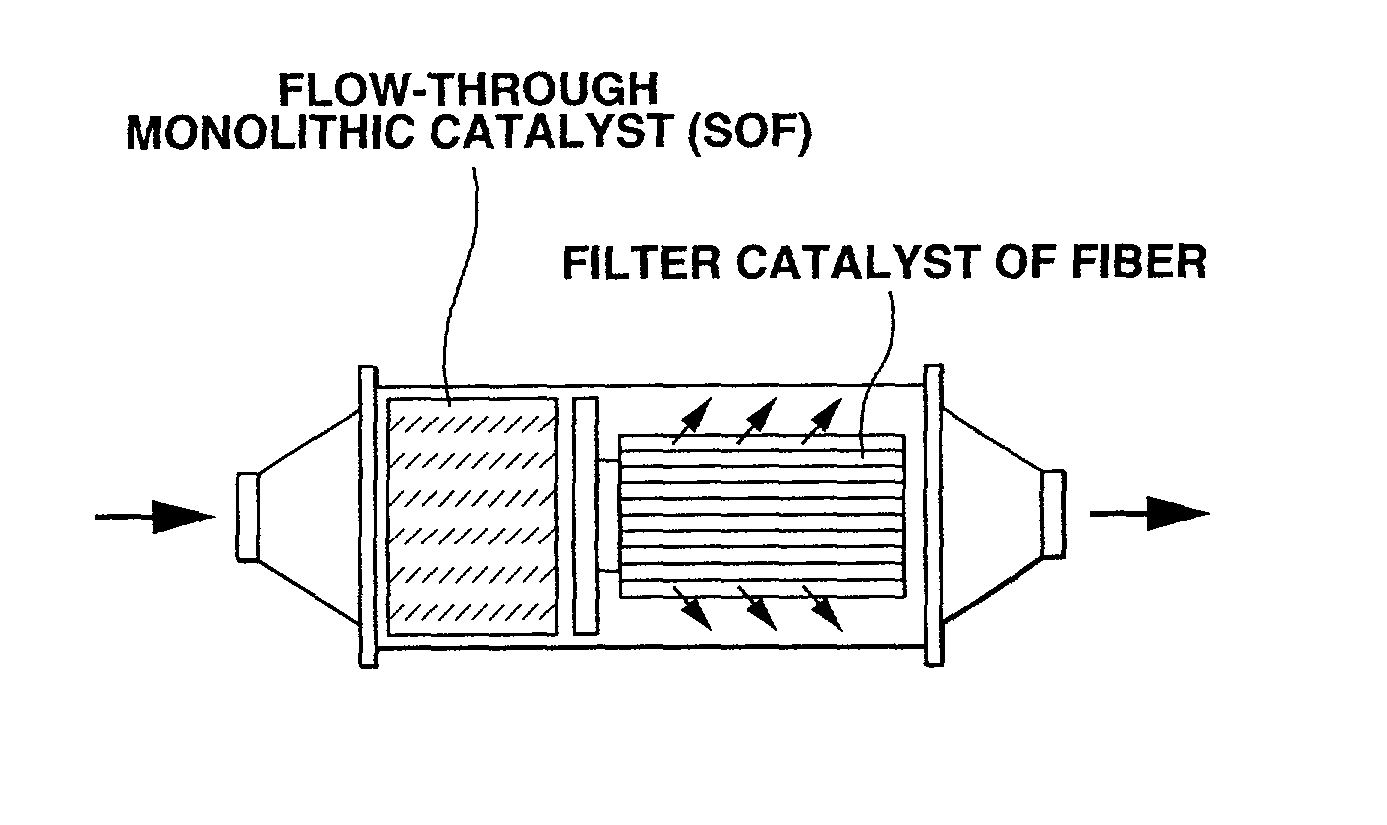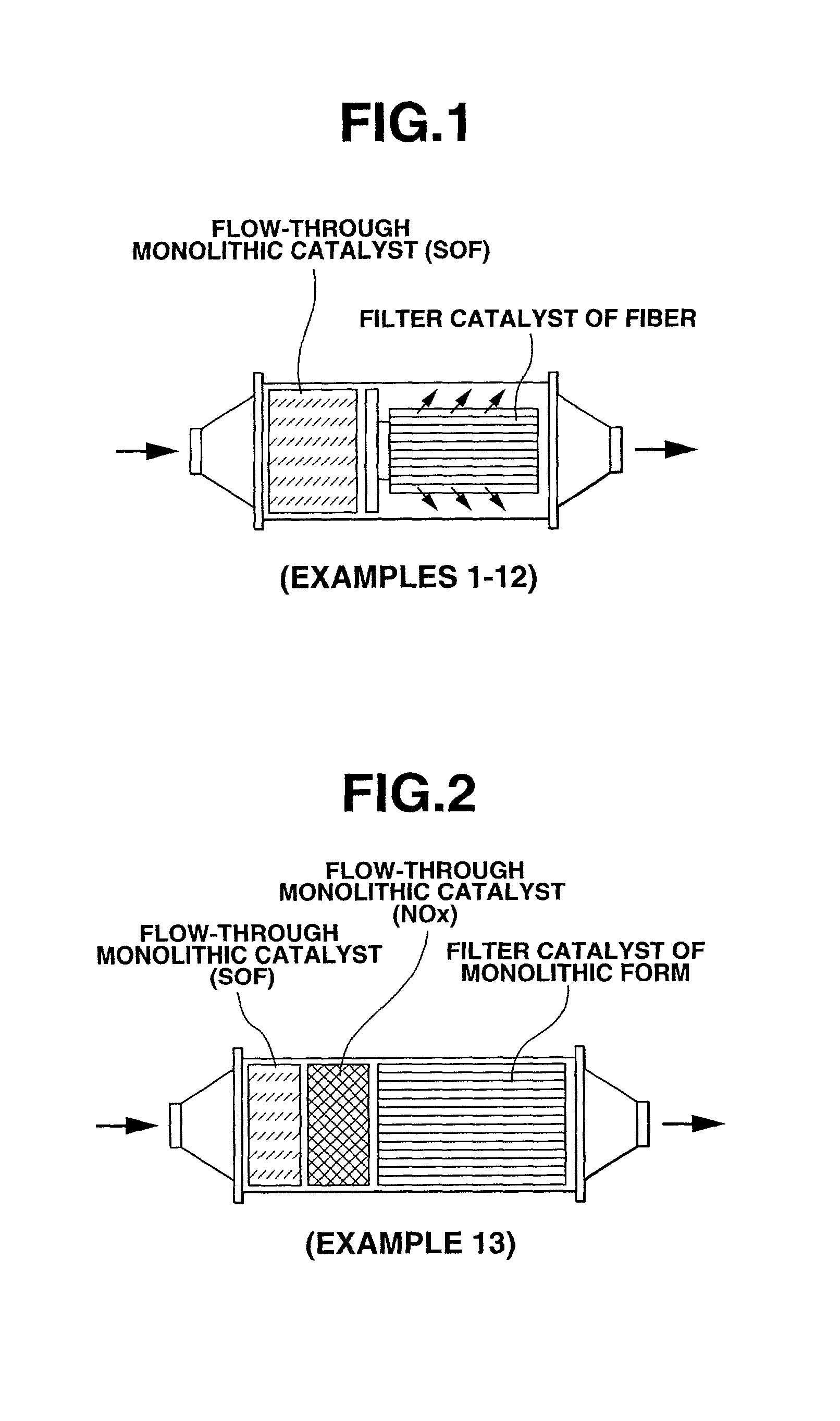Exhaust gas purifying system and method
a technology of exhaust gas and purification system, which is applied in the direction of electrical control, physical/chemical process catalyst, separation process, etc., can solve the problems of difficult purification, insufficient purification of nitrogen oxides (nox), and inability to effectively achieve oxidation or removal of carbon particles (dry soot)
- Summary
- Abstract
- Description
- Claims
- Application Information
AI Technical Summary
Benefits of technology
Problems solved by technology
Method used
Image
Examples
example 1
[0060] (1) Production of Flow-through monolithic carrier for combustion of SOF
[0061] Porous silica having a specific surface area of about 830 m.sup.2 / g and an average pore size of about 3.2 nm was impregnated with an aqueous solution of lanthanum nitrate and an aqueous solution of dinitrodiammine platinum (Pt) having a Pt concentration of about 4% by weight thereby obtaining powdered impregnated porous silica which carried 4.0% by weight of Pt and 1.0% by weight of La. The powdered impregnated silica was mixed with boehmite powder in a weight ratio of 3 (silica):1 (boehmite powder), followed by adding 1% by weight of nitric acid-acidic alumina sol, thereby forming a mixture. The mixture was mixed with water and then pulverized for 60 minutes in a porcelain ball mill pot provided with alumina balls each having a diameter of 7 mm, thus obtaining a slurry.
[0062] This slurry was coated on a cordierite ceramic honeycomb monolithic substrate (having the trade name of HONEYCERAM(R), produ...
examples 2 to 5
[0068] Flow-through monolithic catalysts for combustion of SOF, of Examples 2 to 5 were produced by repeating the procedure (1) in Example 1 with the exception that aqueous solutions of cerium nitrate, iron nitrate, magnesium nitrate and zirconyl nitrate are respectively used in Examples 2, 3, 4 and 5, in place of the aqueous solution of lanthanum nitrate.
[0069] Filter catalysts formed of fiber, of Examples 2 to 5 were produced by repeating the procedure (2) in Example 1.
[0070] Each of the thus produced flow-through monolithic catalyst (for combustion of SOF) and each of the thus produced cylindrical filter catalyst were arranged in series and set in a casing as shown in FIG. 1 in which the monolithic catalyst and the filter catalyst were located respectively on upstream and downstream sides relative to flow of exhaust gas, thereby preparing respectively an exhaust gas purifying systems 2, 3, 4 and 5 of Examples 2, 3, 4 and 5.
examples 6 to 9
[0071] Flow-through monolithic catalysts for combustion of SOF, of Examples 6 to 9 were produced by repeating the procedure (1) in Example 1.
[0072] Filter catalysts formed of fiber, of Examples 6 to 9 were produced by repeating the procedure (2) in Example 1 with the exception that aqueous solutions of lanthanum nitrate, iron nitrate, magnesium nitrate and potassium nitrate were respectively used in Examples 6, 7, 8 and 9, in place of the aqueous solution of cerium nitrate.
[0073] Each of the thus produced flow-through monolithic catalyst (for combustion of SOF) and each of the thus produced cylindrical filter catalyst were arranged in series and set in a casing as shown in FIG. 1 in which the monolithic catalyst and the filter catalyst were located respectively on upstream and downstream sides relative to flow of exhaust gas, thereby preparing respective exhaust gas purifying systems 6, 7, 8 and 9 of Examples 6, 7, 8 and 9.
PUM
| Property | Measurement | Unit |
|---|---|---|
| temperature | aaaaa | aaaaa |
| pore size | aaaaa | aaaaa |
| specific surface area | aaaaa | aaaaa |
Abstract
Description
Claims
Application Information
 Login to View More
Login to View More - R&D
- Intellectual Property
- Life Sciences
- Materials
- Tech Scout
- Unparalleled Data Quality
- Higher Quality Content
- 60% Fewer Hallucinations
Browse by: Latest US Patents, China's latest patents, Technical Efficacy Thesaurus, Application Domain, Technology Topic, Popular Technical Reports.
© 2025 PatSnap. All rights reserved.Legal|Privacy policy|Modern Slavery Act Transparency Statement|Sitemap|About US| Contact US: help@patsnap.com



